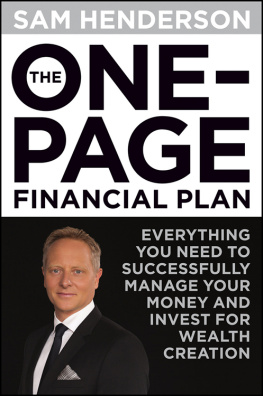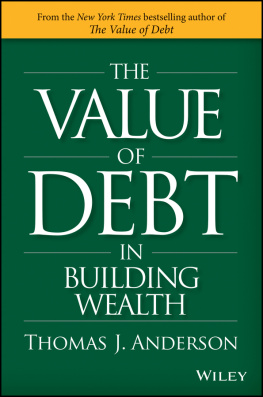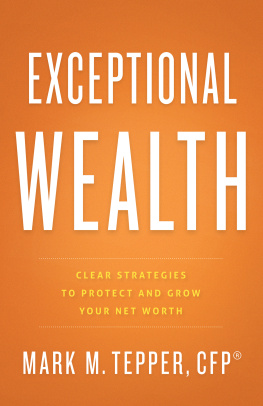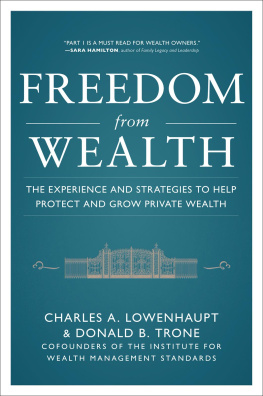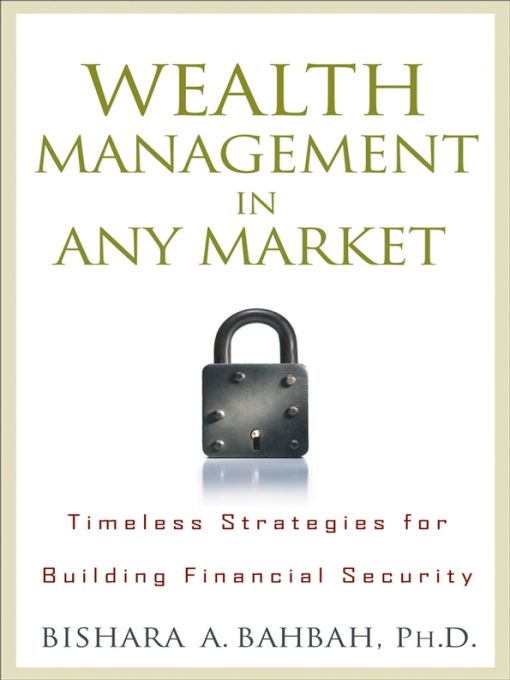Table of Contents
I am an American by choice, not by birth.
I dedicate this book to the country that has provided me
with unlimited opportunities and the prospect of wealth.
This book is a humble attempt to give back to the country
and its people that have given me the most prized of all
giftseducation, freedom, physical, and financial
securityand the ability to work hard and be
rewarded accordingly.
Foreword
Wealth management is a lifelong journey. Like any journey, it helps to know where you want to go and how you want to get there. The route taken will differ for each individual.
It cannot be said often enough: The better and the earlier you plan, the easier it will likely be to reach your financial destination and to secure your future and those of your loved ones. If the journey was a cross-country family vacation, it might be helpful to know the following: what vehicle to use, what roadways to take, and what time to start, rest, or continue, based on the weather forecast, what your average speed will likely be, and what traffic conditions you are likely to face. The same can be said about wealth management. It is equally important to know what vehicle to use and what investments to consider, based on your goals, personal preferences, family dynamics, risk tolerance, and time horizon, as well as possible tax and estate planning ramifications.
As hard as Americans physically work to earn and make money, few people invest the time to develop a wealth management plan that includes a comprehensive financial plan. Such a plan should be in writing and coordinated among a wealth management team that includes an estate planning attorney, a CPA, an insurance agent, a trust officer, and a wealth manager who is also a financial advisor. The team and the plan will allow individuals to have the proper legal framework and the diversified investment vehicles to help achieve ones goals. The financial plan should be comprehensive in nature, aimed at ensuring that all assets are working for the investor in an efficient, risk-adjusted manner. It should be monitored and reviewed on an ongoing basis. The process can seem daunting, considering the myriad of theories on asset allocation, unknown financial outcomes, the complexity of financial vehicles available, and tax and legal structures that tend to change over time. Nobody said it would be easy, but it just got easier.
Dr. Bishara A. Bahbahs book, Wealth Management in Any Market: Timeless Strategies for Building Financial Security, successfully navigates individuals through the arduous process of establishing a comprehensive wealth management plan. Investors at all levelswhether they are starting out the long journey of building financial security, are currently accumulating wealth, or are in the wealth distribution phase of their livesshould benefit tremendously from the comprehensiveness and in-depth research and analysis, backed by facts and figures, found in the book.
Depending on your stage in the wealth life cycle, you will find the book as a whole extremely valuable. Some might find certain chapters more relevant and of exceptional benefit to their particular situations. If retirement planning is on your mindas it should beyou will find strategies and data that will help you build and achieve retirement security. If you are a professionala physician, lawyer, or businesspersonhistorically subject to lawsuits more than most, the chapter on asset protection strategies will provide you with unique insights geared to educate you and help you to protect your hard-earned current and future wealth. Irrespective of your level of wealth, you will find the book informative, easy to read and understand, and quite practical.
I have witnessed the author, Bishara A. Bahbah, over the past ten years develop and implement a holistic approach to financial wealth management that is detailed in this book. I know the motivation for this book came from his personal experience in helping individuals and institutions meet their needs. As a practitioner in the wealth management field with an impressive academic background, Dr. Bahbah is unique among his peer of authors who write about financial and wealth management issues. His insights are not just based on study and research but also emanate from years of being a hands-on wealth advisor. Those who have adopted his approach of comprehensive wealth management have found themselves better served by using his timeless strategies for building financial security.
This book is an invaluable resource on wealth management. It discusses what roads to consider and the many pitfalls to avoid. I know that investors, individuals, and institutions at varying levels of wealth, and irrespective of what stage they are at in the lifelong wealth planning cycle, can greatly benefit from the knowledge and insight exhibited in this must-read book.
Enjoy!
Richard Golod
Director of Global Investment Strategies
Van Kampen Investments
Preface
I could not have written this book at a more tumultuous time in the financial markets since the era of the Great Depression. The bursting of the housing bubble, which affected just about every homeowner in the United States; the subprime lending crisis; the ensuing credit crunch and illiquidity in the financial markets; the unprecedented volatility in commodity prices, especially oil and gold, leading to fears of inflation; the collapse of a major brokerage firm, Bear Stearns Cos., and its fire sale to JP Morgan at $2 a share (subsequently raised to $10 a share, forced by market pressure) from $159 a share a year earlier; the bankruptcy of Lehman Brothers, the absorption of Merrill Lynch by Bank of America; the failure of traditional banks; the Federal Reserves extraordinary interventions, including the fastest and steepest lowering of prime rates in the span of a few short months, to shore up confidence and provide liquidityall these developments combined contributed to a tsunami of upheaval in the financial markets not only in the United States but also throughout the world. In fact, 2008 emerged as the year that rewrote the book, at least since the Great Depression, with regard to the structure of the financial industry in the United States for years to come.
Despite all this gloom and doom, history has demonstrated time and time again that following these epic-style criseswhether engendered by the Great Depression, wars (World War II, the Korean War, the Vietnam War, the war in Afghanistan against the Soviets, the first Gulf War, and the U.S. invasion of Iraq), the assassination or resignation of presidents, extraordinary inflation over an extended period of time, the Cold War, and the bursting of the technology bubblethe markets recover. The latest housing, credit, and financial crises will be no exception.
These violent and unsettling episodes, however, force us to reevaluate our views on money and investing, help us learn from the mistakes and the excesses of the past, and force us to emerge stronger and wiser. This is not to say that the future will not hold in store for the next generations other types of unprecedented financial crises. Such is the course of history.
Reality, however, paints a different and brighter picture. Admittedly, we have not had time to assess the extent of the damage of the most recent crises. We do know that in the last quarter of 2007, U.S. household wealth fell by $533 billion; nevertheless, U.S. household wealth still stood at a staggering $57,718 billion at the end of 2007.



